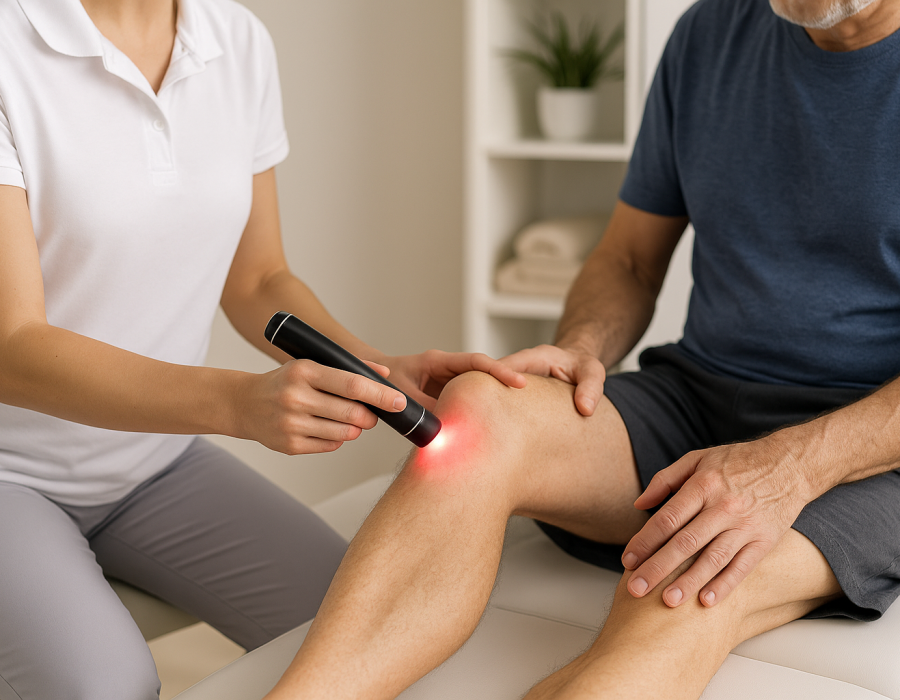Living with chronic pain, injury, or the slow crawl of rehabilitation can feel like you’re stuck in a body that’s betraying you. But science is lighting the way—literally. Cold laser therapy, also known as low-level laser therapy (LLLT), is emerging as a powerful complement to physical therapy, occupational therapy, and other non-invasive treatments aimed at restoring function and relieving pain.
From orthopedic injuries to nerve pain and post-surgical healing, cold laser therapy is gaining traction among providers who are looking for effective, drug-free solutions that work with the body not against it.
What Is Cold Laser Therapy?
Cold laser therapy uses low-level red and near-infrared light to stimulate tissue repair and reduce inflammation. Unlike hot lasers used in surgery, these lasers don’t burn the skin. Instead, the photons penetrate the skin to reach the mitochondria within cells, prompting increased ATP (energy) production and promoting tissue regeneration.
It’s like giving your cells a gentle push to heal smarter and faster.
How It Enhances Recovery
Physical therapists, occupational therapists, and rehab coordinators increasingly include cold laser therapy in their treatment plans. Here’s how it fits:
- Reduces Inflammation: Helps calm swollen, irritated tissues ideal for acute injuries and post-surgical recovery.
- Accelerates Healing: Tissues heal faster when energy production and circulation are improved.
- Alleviates Pain: Reduces nerve sensitivity and supports natural pain modulation.
- Improves Mobility: Patients receiving cold laser in tandem with physical therapy often regain range of motion more quickly.
Whether you’re dealing with musculoskeletal pain, post-operative stiffness, or neuropathic pain, laser therapy acts as a powerful adjunct.
Clinical Evidence in Practice
Research supports its use in physical therapy and rehabilitation:
- Musculoskeletal Pain: Patients with tennis elbow, golfer’s elbow, or back pain report better pain relief when cold laser is combined with stretching and strengthening routines.
- Post-Surgical Healing: Laser therapy helps reduce scar tissue formation and speeds wound healing.
- Sports Injuries: Athletes undergoing orthopedic physical therapy benefit from quicker return-to-play timelines.
- Neurological Physical Therapy: Individuals with nerve injuries or neuropathic pain show improved function and lower pain scores when laser therapy is incorporated.
A 2020 meta-analysis found that patients receiving cold laser therapy experienced significantly more pain relief than those receiving placebo or standard care alone.
Case Spotlight: Raj’s Rehab Comeback
Raj, a 45-year-old warehouse worker, injured his rotator cuff lifting heavy boxes. Surgery was successful, but the stiffness and pain afterward made daily life a challenge. Physical therapy helped, but progress was slow until his rehab coordinator added cold laser therapy.
After a few sessions, Raj noticed less swelling and easier movement. Within eight weeks, he was back at work with full shoulder mobility and minimal discomfort. For Raj, combining laser therapy with traditional rehab wasn’t just helpful it was the turning point.
Benefits of Adding Laser to Therapy Care
- Drug-Free: No pills, no prescriptions just light energy.
- Non-Invasive: Gentle surface treatment, no downtime.
- Faster Results: Supports quicker recovery when paired with active therapies.
- No Major Side Effects: Safe when applied by trained professionals.
- Synergistic: Amplifies the effects of occupational and physical therapy interventions.
A New Standard for Holistic Care
In a world moving away from opioid reliance, cold laser therapy stands out as a science-backed, patient-centered tool. When used alongside traditional therapy services from orthopedic rehabilitation to neurological physical therapy it enhances outcomes, shortens recovery timelines, and supports long-term wellbeing.
Final Thoughts
Recovery is never one-size-fits-all. But combining the expertise of physical therapists, occupational therapists, speech pathologists, and rehab placement specialists with innovative tools like cold laser therapy makes healing more achievable.
From injury rehab to chronic pain relief, this therapy is reshaping the landscape of modern care offering light not just in treatment, but in hope.





Comments